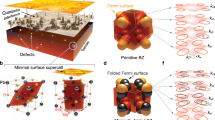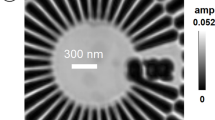Abstract
There is a retraction (October 2006) associated with this Article. Please click here to view. The observation of the detailed atomic arrangement within nanostructures has previously required the use of an electron microscope for imaging. The development of diffractive (lensless) imaging in X-ray science and electron microscopy using ab initio phase retrieval provides a promising tool for nanostructural characterization. We show that it is possible experimentally to reconstruct the atomic-resolution complex image (exit-face wavefunction) of a small particle lying on a thin carbon substrate from its electron microdiffraction pattern alone. We use a modified iterative charge-flipping algorithm and an estimate of the complex substrate image is subtracted at each iteration. The diffraction pattern is recorded using a parallel beam with a diameter of ∼50 nm, illuminating a gold nanoparticle of ∼13.6 nm diameter. Prior knowledge of the boundary of the object is not required. The method has the advantage that the reconstructed exit-face wavefunction is free of the aberrations of the objective lens normally used in the microscope, whereas resolution is limited only by thermal vibration and noise.
This is a preview of subscription content, access via your institution
Access options
Subscribe to this journal
Receive 12 print issues and online access
$259.00 per year
only $21.58 per issue
Buy this article
- Purchase on Springer Link
- Instant access to full article PDF
Prices may be subject to local taxes which are calculated during checkout





Similar content being viewed by others
References
Chapman, H. N. et al. High-resolution ab initio three-dimensional X-ray diffraction microscopy. J. Opt. Soc. Am. A (in the press).
Zuo, J. M., Vartanyants, I., Gao, M., Zhang, R. & Nagahara, L. A. Atomic resolution imaging of a carbon nanotube from diffraction intensities. Science 300, 1419–1421 (2003).
Shapiro, D. et al. Biological imaging by soft x-ray diffraction microscopy. Proc. Natl Acad. Sci. USA 102, 15343–15346 (2005).
McMahon, P. J. et al. Quantitative phase radiography with polychromatic neutrons. Phys. Rev. Lett. 91, 145502 (2003).
Scherzer, O. The theoretical resolution limit of the electron microscope. J. Appl. Phys. 20, 20–29 (1949).
Coene, W., Janssen, G., Op de Beeck, M. & Van Dyck, D. Phase retrieval through Focus variation for ultra-resolution in field-emission transmission electron microscopy. Phys. Rev. Lett. 69, 3743–3746 (1992).
Haider, M., Uhlemann, S., Schwan, E., Kabius, B. & Urban, K. Electron microscope image enhanced. Nature 392, 768–769 (1998).
Spence, J. C. H. Oxygen in crystals—seeing is believing. Science 299, 839–840 (2003).
Jia, C. L., Lentzen, M. & Urban, K. Atomic-resolution imaging of oxygen in perovskite ceramics. Science 299, 870–873 (2003).
Orchowski, A., Rau, W. D. & Lichte, H. Electron holography surmounts resolution limit of electron microscopy. Phys. Rev. Lett. 74, 399–402 (1995).
Glaeser, R. Review: Electron crystallography: present excitement, a nod to the past, anticipating the future. J. Struct. Biol. 128, 3–14 (1999).
Miao, J. W., Charalambous, C., Kirz, J. & Sayre, D. Extending the methodology of X-ray crystallography to allow imaging of micrometre-sized non-crystalline specimens. Nature 400, 342–344 (1999).
Gerchberg, R. W. & Saxton, W. O. Practical algorithm for determination of phase from image and diffraction plane pictures. Optik 35, 237–246 (1972).
Fienup, J. R. Phase retrieval algorithms: a comparison. Appl. Opt. 21, 2758–2769 (1982).
Oszlányi, G. & Sütő, A. Ab initio structure solution by charge flipping. Acta Crystallogr. A 60, 134–141 (2004).
Wu, J. S., Spence, J. C. H., O’Keeffe, M. & Groy, T. Application of a modified Oszlányi and Süto ab initio charge-flipping algorithm to experimental data. Acta Crystallogr. A 60, 326–330 (2004).
Wu, J. S., Weierstall, U., Spence, J. C. H. & Koch, C. T. Iterative phase retrieval without support. Opt. Lett. 29, 2737–2739 (2004).
Spence, J. C. H. High-resolution Electron Microscopy (Oxford Univ. Press, Oxford and New York, 2003).
Spence, J. C. H., Weierstall, U. & Howells, M. Coherence and sampling requirements for diffractive imaging. Ultramicroscopy 101, 149–152 (2004).
Wu, J. S. & Spence, J. C. H. Reconstruction of complex single-particle images using the charge-flipping algorithm. Acta Crystallogr. A 61, 194–200 (2005).
Marchesini, S. et al. X-ray image reconstruction from a diffraction pattern alone. Phys. Rev. B 68, 140101 (2003).
Oszlányi, G. & Sütő, A. Ab initio structure solution by charge flipping II. Use of weak reflections. Acta Crystallogr. A 61, 147–152 (2005).
Seldin, J. & Fienup, J. R. Numerical investigations of the uniqueness of phase retrieval. J. Opt. Soc. Am. 7, 412–427 (1990).
Buerger, M. J. Proofs and generalizations of pattersons theorems on homometric complementary sets. Z. Kristallogr. 143, 79–98 (1976).
Acknowledgements
This work was supported by ARO award W911NF-05-1-0152 and a UK EPSRC award.
Author information
Authors and Affiliations
Corresponding author
Ethics declarations
Competing interests
The authors declare no competing financial interests.
Supplementary information
Supplementary Information
Supplementary information and figure S1 (PDF 393 kb)
Rights and permissions
About this article
Cite this article
Wu, J., Weierstall, U. & Spence, J. Diffractive electron imaging of nanoparticles on a substrate. Nature Mater 4, 912–916 (2005). https://doi.org/10.1038/nmat1531
Received:
Accepted:
Published:
Issue Date:
DOI: https://doi.org/10.1038/nmat1531
This article is cited by
-
Retraction Note to: Diffractive imaging of nanoparticles on a substrate
Nature Materials (2006)
-
Ab initio phasing of X-ray powder diffraction patterns by charge flipping
Nature Materials (2006)
-
Cutting the cost of high-resolution microscopy
Nature Materials (2005)



